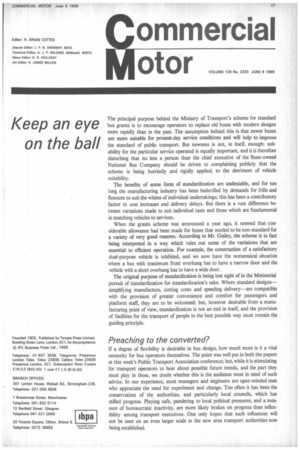Keep an eye on the ball
Page 29

If you've noticed an error in this article please click here to report it so we can fix it.
The principal purpose behind the Ministry of Transport's scheme for standard bus grants is to encourage operators to replace old buses with modern designs more rapidly than in the past. The assumption behind this is that newer buses are more suitable for present-day service conditions and will help to improve the standard of public transport. But newness is not, in itself, enough; suitability for the particular service operated is equally important, and it is therefore disturbing that no less a person than the chief executive of the State-owned National Bus Company should be driven to complaining publicly that the scheme is being hurriedly and rigidly applied, to the detriment of vehicle suitability.
The benefits of some form of standardization are undeniable, and for too long the manufacturing industry has been bedevilled by demands for frills and flounces to suit the whims of individual undertakings; this has been a contributory factor in cost increases and delivery delays. But there is a vast difference between variations made to suit individual taste and those which are fundamental in matching vehicles to services.
When the grants scheme was announced a year ago, it seemed that considerable allowance had been made for buses that needed to be non-standard for a variety of very good reasons. According to Mr. Galley, the scheme is in fact being interpreted in a way which rules out some of the variations that are essential to efficient operation. For example, the construction of a satisfactory dual-purpose vehicle is inhibited, and we now have the nonsensical situation where a bus with maximum front overhang has to have a narrow door and the vehicle with a short overhang has to have a wide door.
The original purpose of standardization is being lost sight of in the Ministerial pursuit of standardization for standardization's sake. Where standard designs simplifying manufacture, cutting costs and speeding delivery—are compatible with the provision of greater convenience and comfort for passengers and platform staff, they are to be welcomed; but, however desirable from a manufacturing point of view, 'standardization is not an end in itself, and the provision of facilities for the transport of people in the best possible way must remain the guiding principle.
Preaching to the converted?
If a degree of flexibility is desirable in bus design, how much more is it a vital necessity for bus operators themselves. The point was well put in both the papers at this week's Public Transport Association conference; but, while it is stimulating for transport operators to hear about possible future trends, and the part they must play in these, we doubt whether this is the audience most in need of such advice. In our experience, most managers and engineers are open-minded men who appreciate the need for experiment and change. Too often it has been the conservatism of the authorities, and particularly local councils, which has stifled progress. Playing safe, pandering to local political pressures, and a measure of bureaucratic inactivity, are more likely brakes on progress than inflexibility among transport executives. One only hopes that such influences will not be seen on an even larger scale in the new area transport authorities now being established.


























































































































